
ATTENTION: The works hosted here are being migrated to a new repository that will consolidate resources, improve discoverability, and better show UTA's research impact on the global community. We will update authors as the migration progresses. Please see MavMatrix for more information.
Show simple item record
| dc.contributor.advisor | Basu, Asish R | |
| dc.creator | Chakrabarty, Puloma | |
| dc.date.accessioned | 2021-06-03T19:57:48Z | |
| dc.date.available | 2021-06-03T19:57:48Z | |
| dc.date.created | 2019-05 | |
| dc.date.issued | 2019-05-07 | |
| dc.date.submitted | May 2019 | |
| dc.identifier.uri | http://hdl.handle.net/10106/29884 | |
| dc.description.abstract | The Cretaceous Period (145-66 Ma), with no magnetic reversal for ~79 Ma, is generally termed as the Cretaceous Normal Superchron or the Magnetic Quiet Zone. There is evidence of at least two major large scale, global volcanisms in this long period synchronous with mass extinctions, during the Late Cretaceous and at the end of the Cretaceous.
This study focusses on the effect of these two global volcanisms on
1. The Ocean: Eagle Ford, South Texas at the beginning of the Late Cretaceous, 93.9 Ma, probably caused by Cretaceous mafic volcanism from the Ontong Java Plateau and/or Caribbean Large Igneous Province volcanism (LIP), and
2. The Land: Deccan Traps, end-Cretaceous, 66 Ma, LIP volcanism. | |
| dc.format.mimetype | application/pdf | |
| dc.language.iso | en_US | |
| dc.subject | Eagle Ford Shale | |
| dc.subject | Acid volcanism deccan | |
| dc.title | TWO CRETACEOUS TALES OF THE LAND AND THE SEA | |
| dc.type | Thesis | |
| dc.degree.department | Earth and Environmental Sciences | |
| dc.degree.name | Doctor of Philosophy in Earth and Environmental Science | |
| dc.date.updated | 2021-06-03T19:57:49Z | |
| thesis.degree.department | Earth and Environmental Sciences | |
| thesis.degree.grantor | The University of Texas at Arlington | |
| thesis.degree.level | Doctoral | |
| thesis.degree.name | Doctor of Philosophy in Earth and Environmental Science | |
| dc.type.material | text | |
| dc.creator.orcid | 0000-0001-9181-5157 | |
Files in this item
- Name:
- CHAKRABARTY-DISSERTATION-2019.pdf
- Size:
- 16.76Mb
- Format:
- PDF
This item appears in the following Collection(s)
Show simple item record


